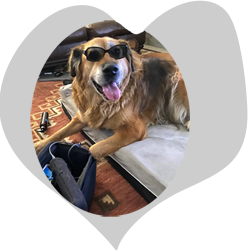At A Friend of A Family Pet Care, we specialize in canine rehabilitation. Our dedicated team provides personalized care, tailored exercises, and therapeutic activities to support your furry friend’s recovery and overall well-being. Whether it’s post-surgery rehabilitation, mobility improvement, or pain management, we’re here to help your canine companion thrive.
-
Low-level Laser Therapy
 Low-level laser therapy (LLLT), also known as photobiomodulation, is a noninvasive, pain-free treatment that uses low-intensity light to stimulate biochemical changes in cells. It helps repair tissue and reduce inflammation. One common application of LLLT is stimulating hair regrowth in individuals with hereditary hair loss. Additionally, LLLT is used in physical therapy, sports medicine, and chiropractic treatment. The precise biochemical mechanisms underlying its therapeutic effects are not fully understood, but it appears to have a wide range of positive effects at various levels within the body. For instance, LLLT acts on mitochondria (the cellular “power plants”) to increase energy, promoting regeneration and healing of damaged muscles, ligaments, nerves, bones, joints, and soft tissue. The term “cold” laser therapy refers to the fact that the low levels of light do not generate heat, resulting in no sensation or burning. LLLT has been shown to increase the proliferation of various cell types, including fibroblasts, keratinocytes, endothelial cells, and lymphocytes. It’s a safe and promising modality for various conditions.
Low-level laser therapy (LLLT), also known as photobiomodulation, is a noninvasive, pain-free treatment that uses low-intensity light to stimulate biochemical changes in cells. It helps repair tissue and reduce inflammation. One common application of LLLT is stimulating hair regrowth in individuals with hereditary hair loss. Additionally, LLLT is used in physical therapy, sports medicine, and chiropractic treatment. The precise biochemical mechanisms underlying its therapeutic effects are not fully understood, but it appears to have a wide range of positive effects at various levels within the body. For instance, LLLT acts on mitochondria (the cellular “power plants”) to increase energy, promoting regeneration and healing of damaged muscles, ligaments, nerves, bones, joints, and soft tissue. The term “cold” laser therapy refers to the fact that the low levels of light do not generate heat, resulting in no sensation or burning. LLLT has been shown to increase the proliferation of various cell types, including fibroblasts, keratinocytes, endothelial cells, and lymphocytes. It’s a safe and promising modality for various conditions. Exercise
When it comes to canine recovery, tailored exercise and play are essential. Here are some guidelines and activities to aid in your dog’s recuperation:
- Activity Guidelines
Set clear guidelines for specific activities. Owners should be given clear instructions regarding appropriate activities for their recovering pet.Walking slowly, walking fast, trotting, running, moving up or down slopes, sitting straight, standing with all four paws on the ground, stepping over curb or doorsteps, turning tightly, standing up on hind legs, and going up or down sets of steps.Overactivity can lead to complications, especially after orthopedic surgery. It’s important to prevent unhealthy movement patterns. - Canine Rehabilitation Therapy
Consider using exercise balls, balance blocks, therabands, or wobble boards.Incremental weight and resistance training can be helpful in some cases. - Passive Range of Motion (PROM) Exercises Gently move your dog’s joints through their full range of motion. This helps maintain joint flexibility and prevent stiffness.
-
Strength Training

Use treats or toys to encourage controlled movements. For example, encourage your dog to bend or turn slowly toward their shoulder while eating a treat.Focus on neck extension by holding a treat down between the dog’s front legs at chest level.
- Activity Guidelines
-
Crate Rest
After surgery or injury, crate rest is often necessary. It helps prevent over-exuberant activity and allows tissues to heal.Owners should be given clear instructions regarding appropriate activities for their recovering pet.Attention to detail is crucial during exercise restriction. Tailor advice to the patient, owner, and home surroundings.